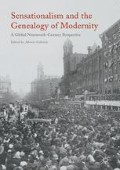Abstract
Devine situates Stephen Crane’s “The Open Boat” at the end of the panoramic age, when the 360-degree promise of encyclopedic perception gave way to a very different kind of visual turn: what Tom Gunning terms “the cinema of attractions.” Crane’s work is read as an allegory of the machine age, when new audiences were consuming a cinematic culture of incessant motion, which blurred the line between spectator and participant. Drawing on early panoramic films and the work of painter Everett Shinn and his contemporaries in the Ashcan School, Devine shows how the panorama was inflected across the arts as a century turned.
Access this chapter
Tax calculation will be finalised at checkout
Purchases are for personal use only
Works Cited
AMB Picture Catalogue. In the Grip of the Blizzard. 1902. http://www.afi.com/members/catalog/DetailView.aspx?s=1&Movie=31999 (accessed July 10, 2014).
Anonymous. The Blizzard. American Mutoscope and Biograph Co.: 1899, in “Picturing a Metropolis: New York City Unveiled.” Unseen Cinema: Early American Avant-Garde Film 1894–1941. Anthology Film Archives. 2005. DVD.
Bentley, Nancy. Frantic Panoramas: American Literature and Mass Culture, 1870–1920. Philadelphia: University of Pennsylvania Press, 2009. Print.
Biers, Katherine. Virtual Modernism: Writing and Technology in the Progressive Era. Minneapolis: University of Minnesota Press, 2013. Print.
Brooks, Daphne. Bodies in Dissent: Spectacular Performances of Race and Freedom, 1850–1910. Durham: Duke University Press, 2006. Print.
Brown, Bill. The Material Unconscious: American Amusement, Stephen Crane, and the Economics of Play. Cambridge: Harvard University Press, 1997. Print.
Crane, Stephen. The Open Boat and Other Stories. New York: Dover, 1993. Print.
Dulac, Nicolas, and Andre Gaudreault. “Circularity and Repetition at the Heart of the Attraction: Optical Toys and the Emergence of a New Cultural Series.” Cinema of Attractions Reloaded. Ed. Wanda Strauven. Amsterdam: Amsterdam University Press, 2006. 227–244. Print.
Edison Catalogue. “A Street Arab: Contemporary Edison Company Catalogue.” From Library of Congress: American Memory—Early Motion Pictures 1897–1920. http://memory.loc.gov/cgi-bin/query/h?ammem/papr:@field%28NUMBER+@band%28lcmp002+m2a32868%29%29 (accessed July 1, 2014).
Fagg, John. On the Cusp: Stephen Crane, George Bellows, and Modernism. Tuscaloosa: University of Alabama Press, 2009. Print.
Foutch, Ellery. “Tough Girls.” Moving Pictures: American Art and Early Film, 1880–1910. Ed. Nancy Mowll Matthews with Charles Musser. Manchester, VT: Hudson Hills Press, 2005. 134–138. Print.
Gaskill, Nicholas. “Red Cars with Red Lights and Red Drivers: Color, Crane, and Qualia.” American Literature 81.4 (December 2009): 719–745. Print.
Gopnik, Adam. From Paris to the Moon. New York: Random House, 2000. Print.
Gunning, Tom. “An Aesthetic of Astonishment: Early Film and the (In)credulous Spectator.” Reprinted in Viewing Positions: Ways of Seeing Film. Ed. Linda Williams. New Brunswick: Rutgers University Press, 1995. 114–133. Print.
———. “The Birth of Film Out of the Spirit of Modernity.” Masterpieces of Modernist Cinema. Bloomington: Indiana University Press, 2006. 13–40. Print.
———. “Chaplin and the Body of Modernity.” Early Popular Visual Culture. 8:3 (August 2010): 237–245. Print.
———. “‘Now You See It, Now You Don’t’: The Temporality of the Cinema of Attractions.” Velvet Light Trap 32 (Fall 1993): 3–12. Print.
Griffiths, Alison. “‘Journeys for Those Who Cannot Travel’: Promenade Cinema and the Museum Life Group.” Wide Angle 18:3 (July 1996): 53–84. Print.
———. “The Revered Gaze: The Medieval Imaginary of Mel Gibson’s The Passion of the Christ.” Cinema Journal 46:2 (Winter 2007): 3–39. Print.
Jarenski, Shelly. “‘Delighted and Instructed’: African American Challenges to Panoramic Aesthetics in J.P. Ball, Kara Walker, and Frederick Douglass.” American Quarterly 65:1 (March 2013): 119–155. Print.
Mathews, Nancy Mowll. “The City in Motion.” Moving Pictures: American Art and Early Film, 1880–1910. Ed. Nancy Mowll Matthews with Charles Musser. Manchester, VT: Hudson Hills Press, 2005. 117–129. Print.
Mazow, Leo G. “Panoramic Sensibilities in Nineteenth- and Twentieth-Century American Painting.” An Endless Panorama of Beauty: Selections from the Jean and Alvin Snowiss Collection of American Art. University Park: Pennsylvania State University Press, 2002. 1–9. Print.
Miller, Angela. “The Panorama, the Cinema, and the Emergence of the Spectacular.” Wide Angle 18:2 (April 1996): 34–69. Print.
North, Michael. Camera Works: Photography and the Twentieth-Century Word. Oxford: Oxford University Press, 2005. Print.
———. Machine-Age Comedy. Oxford: Oxford University Press, 2009. Print.
Posner, Bruce. Note for The Blizzard in “Picturing a Metropolis: New York City Unveiled.” Unseen Cinema: Early American Avant-Garde Film 1894–1941. New York: Anthology Film Archives. 2005. DVD.
Rabinovitz, Lauren. Electric Dreamland: Amusement Parks, Movies, and American Modernity. New York: Columbia University Press, 2012. Print.
Shinn, Everett. “Everett Shinn on George Luks: An Unpublished Memoir.” Archives of American Art Journal 6:2 (April 1966): 1–12. Print.
Snyder, Robert W. and Rebecca Zurier. “Picturing the City.” Metropolitan Lives: The Ashcan Artists and Their New York. New York: W.W. Norton, 1995. 85–190. Print.
Uricchio, William. “A ‘Proper Point of View’: The Panorama and Some of its Early Media Iterations.” Early Popular Visual Culture 9:3 (2011): 225–238. Print.
Yount, Sylvia L. “Consuming Drama: Everett Shinn and the Spectacular City.” American Art 6:4 (Autumn 1992): 86–109. Print.
Zurier, Rebeca. Picturing the City: Urban Vision and the Ashcan School. Berkeley: University of California Press, 2006. Print.
Author information
Authors and Affiliations
Editor information
Editors and Affiliations
Copyright information
© 2017 The Author(s)
About this chapter
Cite this chapter
Devine, M. (2017). The Whole Thing (and Other Things): From Panorama to Attraction in Stephen Crane’s “The Open Boat,” Ashcan Painting, and Early Cinema. In: Gabriele, A. (eds) Sensationalism and the Genealogy of Modernity. Palgrave Macmillan, New York. https://doi.org/10.1057/978-1-137-56148-0_10
Download citation
DOI: https://doi.org/10.1057/978-1-137-56148-0_10
Published:
Publisher Name: Palgrave Macmillan, New York
Print ISBN: 978-1-137-60128-5
Online ISBN: 978-1-137-56148-0
eBook Packages: Literature, Cultural and Media StudiesLiterature, Cultural and Media Studies (R0)

